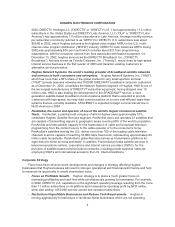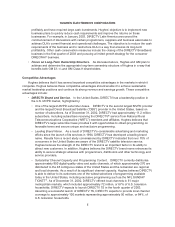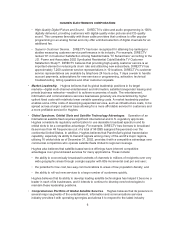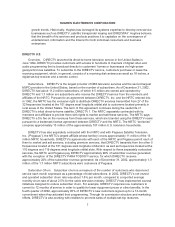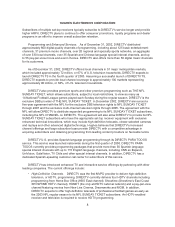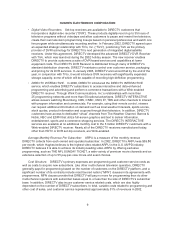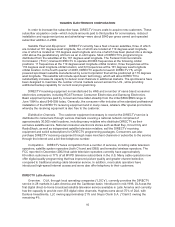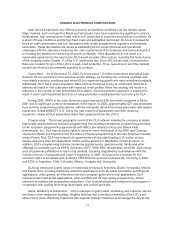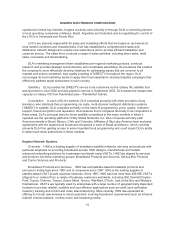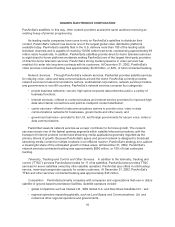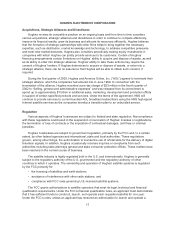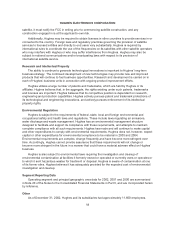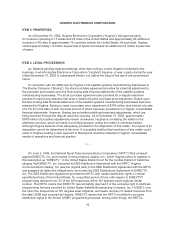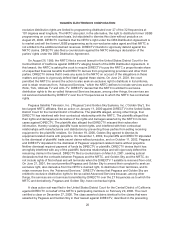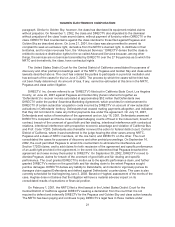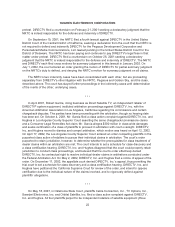DIRECTV 2002 Annual Report Download - page 24
Download and view the complete annual report
Please find page 24 of the 2002 DIRECTV annual report below. You can navigate through the pages in the report by either clicking on the pages listed below, or by using the keyword search tool below to find specific information within the annual report.HUGHES ELECTRONICS CORPORATION
PanAmSat
Overview. PanAmSat, which is approximately 81% owned by Hughes, is a leading global
provider of video, broadcasting and network services through satellites. PanAmSat is traded on the
NASDAQ®stock market under the ticker symbol “SPOT.” PanAmSat leases transponder capacity on
its satellites and is the distribution platform for the delivery of entertainment and information to cable
television systems, television broadcast affiliates, direct-to-home television services, ISPs,
telecommunications companies and other corporations and governments. PanAmSat’s customers
consist of some of the world’s leading media and communications companies, including AOL Time
Warner (which includes Home Box Office and Turner Broadcasting System), the BBC, News Corp.
(Fox family of channels), Sony, Viacom and The Walt Disney Company (which includes ABC and
ESPN). PanAmSat operates in the most mature segment of the satellite communications business,
historically characterized by steady and predictable revenue streams, strong cash flows from
operations, substantial revenue backlog and high barriers to entry.
PanAmSat owns and operates 21 satellites in 16 orbital slots that include approximately
913 36-megahertz equivalent transponders. At December 31, 2002, PanAmSat was utilizing
approximately 71% of its useable and available transponders, which excludes transponders dedicated
for backup to customers and those unavailable for regulatory or technical reasons. One of PanAmSat’s
strategies is to pursue additional revenue opportunities by cross-selling incremental services to its
existing customers and by pursuing new customers in new markets to absorb unutilized capacity. This
strategy requires minimal incremental costs and no significant additional capital expenditures.
PanAmSat’s fleet of spacecraft makes it one of the world’s largest commercial geostationary earth
orbit or “GEO” satellite networks, capable of reaching over 98% of the world’s population. It is one of
only a few companies capable of servicing a global footprint through an owned fleet of satellites.
PanAmSat also has one of the most sophisticated ground infrastructure networks available to support
the needs of its customers. PanAmSat operates teleports in six U.S. locations, each of which provides
transmission, monitoring and control services for operating its fleet. PanAmSat leases such services
outside of the United States to support the remainder of its worldwide satellite fleet.
Part of PanAmSat’s strategy is to expand into new markets. PanAmSat has positioned certain
satellites to cover markets that it has been granted access to serve, as well as markets with strong
growth prospects due primarily to poor existing telecommunications infrastructure. Additionally,
PanAmSat has satellites with coverage of markets in which prior regulations may have prevented
penetration by satellite communications companies. Upon gaining access to these markets through
liberalized regulations, joint ventures or a combination of the two, PanAmSat will have the
infrastructure in place to begin servicing new customers and grow its business. For example, Mexico,
Brazil and India present opportunities for this kind of business expansion.
In 2002, PanAmSat completed its $2.0 billion fleet modernization program, which added
approximately 400 transponders to its fleet. The completion of this program has allowed PanAmSat to
dramatically decrease its forecasted future capital expenditures, which will improve cash flow and
profitability. PanAmSat is currently constructing and expects to launch up to four satellites by 2006.
PanAmSat expects to launch Galaxy XII in the second quarter of 2003 and expects to launch the
Galaxy XIII/Horizons-1 satellite in mid 2003. PanAmSat is currently scheduled to launch a third satellite
to replace Galaxy V prior to the end of its useful life in 2005. The fourth satellite is scheduled to replace
Galaxy 1R prior to the end of its useful life in 2006.
14


